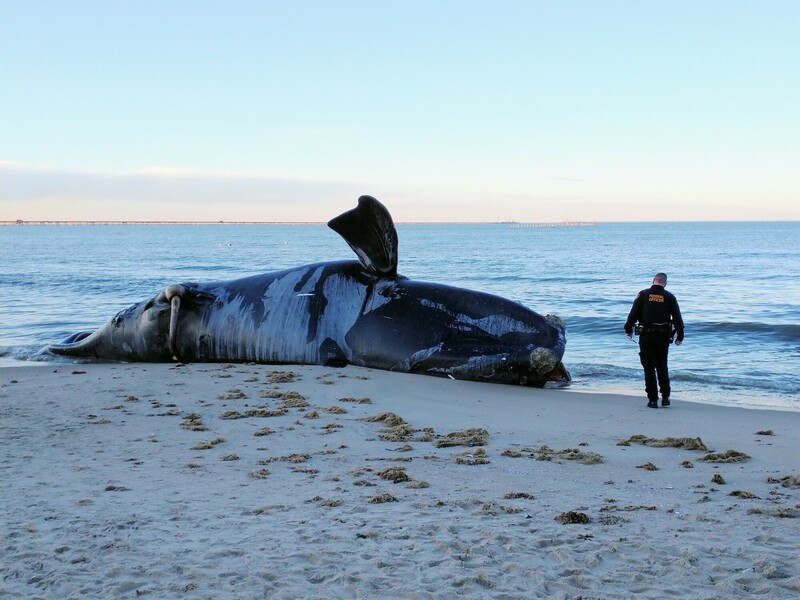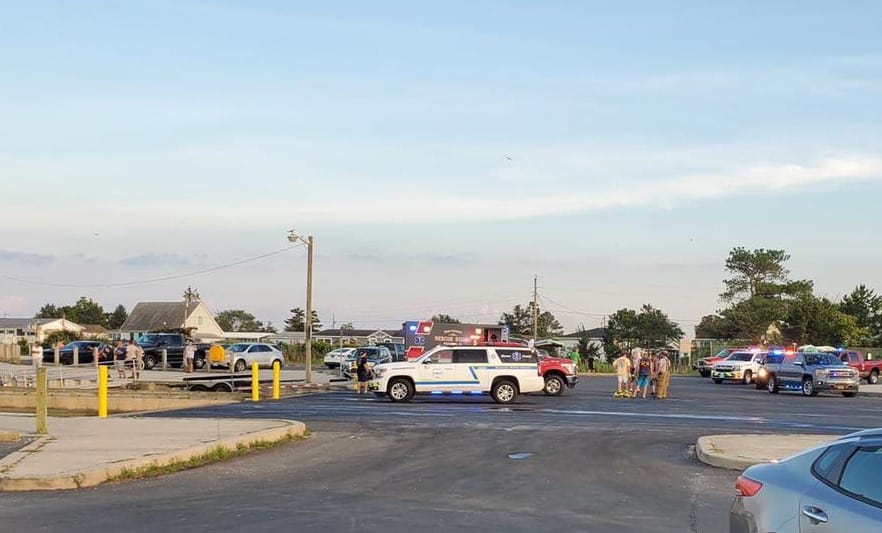A dead whale has washed up in Virginia Beach, the second in just over two weeks. This one was a highly endangered North Atlantic right whale, and its death is being blamed on a vessel collision.
The whale washed up on the shore Sunday, Feb. 12 at Chic’s Beach and a necropsy was conducted and led by the Virginia Aquarium Stranding Response Program, University of North Carolina Wilmington, and the City of Virginia Beach’s Beach Operations Division.
The National Oceanic and Atmospheric Administration (NOAA) Fisheries announced the cause of death was “blunt force trauma” impacting a large portion of the vertebral column, indicating the large mammal was struck by a passing vessel.
The 20-year-old, 43-foot-long male right whale was found not far from the busy Port of Virginia, though it hasn’t been determined where he was struck.
There are Seasonal Management Areas off all major ports in the Mid-Atlantic region, including the Chesapeake Bay, which are in effect through April 30, 2023, a NOAA spokesperson tells us. All vessels 65 feet or longer must travel at 10 knots or less in these areas. (The Center for Biological Diversity notes that military vessels are exempt from the restriction.)
There is also an active voluntary SLOW Zone for all vessels off the Bay that is in effect through February 23, 2023. Maintaining speeds of 10 knots or less can help protect right whales from vessel collisions, NOAA says.
A group of marine mammal conservation groups put out a press release this week condemning the latest right whale death and blaming regulatory lag time on putting stricter regulations into place.
“Ongoing delays in improving protections are the reason we are losing right whales,” said Regina Asmutis-Silvia, executive director of Whale and Dolphin Conservation. “…These whales can’t survive on the hope of future actions. They need protections now.”
NOAA Fisheries proposed tighter right whale protections off the East Coast back in the summer of 2022, which were met with resistance from the charter fishing industry and other boaters. The new rules would extend 10-knot speed limits to boats as small as 35 feet long and would push the use of ropeless, “on-demand” fishing gear to reduce entanglements.
As NOAA Fisheries sought public comment on the proposed rules, conservation groups felt the process wasn’t moving fast enough. As the winter calving season began they filed an emergency petition to put the rules into place immediately, but NOAA denied the request.
“This whale’s death is a tragic reminder of the constant danger North Atlantic right whales are facing,” said Kristen Monsell, oceans legal director at the Center for Biological Diversity. “Right whales desperately and immediately need more protections from vessel strikes and all the other human-caused threats they encounter. Otherwise this species is likely to go extinct.”
North Atlantic right whales are critically endangered, with only about 340 individuals remaining.
Conservation group Oceana says right whales are particularly vulnerable to vessel strikes because they travel at only about 6 miles per hour, usually near the surface. But they’re tricky for ships’ crews to spot because they’re dark in color with no dorsal fin sticking up. The group says tighter restrictions need to be put in place faster or more whales could die.
“North Atlantic right whales weave through thousands of boats that travel in and out of ports up and down the eastern seaboard—directly in their migratory zone. Every day this rule is delayed pushes these whales closer to the brink of extinction,” says Oceana Campaign Director Gib Brogan.
An Unusual Mortality Event (UME) has been underway since 2017 to investigate the increasing number of deaths in recent years..
A UME has also been underway for humpback whales since 2016. Humpbacks have seen an especially deadly few months. More than a dozen have been found dead from Virginia to New York since December.
A humpback whale was found floating near the Lynnhaven Inlet in Virginia Beach on Feb. 7, and was later brought ashore for a necropsy to be performed. In mid-January, a humpback washed up on the beach at Assateague Island National Seashore. Necropsy showed an area of hemorrhage along the whale’s left side, a NOAA spokesperson tells Bay Bulletin. This “could be consistent with suspect blunt force trauma (vessel strike),” NOAA says. Samples were taken to see if those injuries happened before or after death.
Vessel strikes and entanglements in commercial fishing gear are two leading causes of large whale deaths in the mid-Atlantic.
-Meg Walburn Viviano




